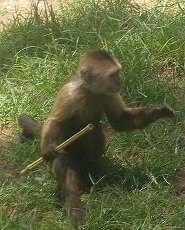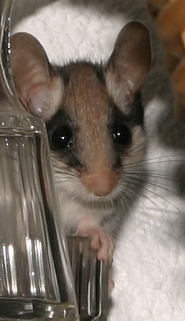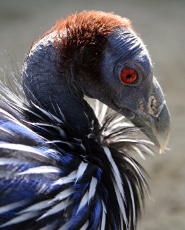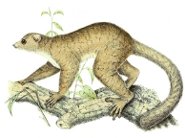Thursday 24 July 2014
The Weeping capuchin- a Social Learner

Weeping capuchins (
Cebus olivaceus) are also called wedge-capped monkeys because of the dark hair on the top of their head resembling a monk’s cap. They are native to the semi-deciduous, tropical forest of South America in
Venezuela,
Guyana, and the Amazon Basin. Coloration is tan or cream, with a white face and chest and a wedge of dark hair on the top of the head. Weeping capuchins weigh an average of 2.5 to 3 kg (5.5-6.6 lbs.), with the male weighing up to 800g (1.7 lbs.) more than the female. Average length is 500 mm (19.6 in) and tails are as long as the body making the over-all length 840 mm (33 in). Their tail is prehensile, which means it can support their entire hanging weight. This skill is handy as they can use both hands to pick and eat food. Fruit, nuts, flowers, buds, bark, bird eggs, small vertebrates, insects, spiders, and crabs make up their diet. Weeping capuchin monkeys live in bands or troops, consisting of 10 to 30 members. Most of the members are females with their young, a few males, and a dominant male. The dominant male is the only one that mates with the females. Mating season is from October to February, but may be year-round, and females have one offspring every 18-24 months. Gestation is 145-170 days. The infants are able to grasp onto their mother’s chest within minutes of birth and spend the first few months clinging to her. Females mature in four years, males in 7. Weeping capuchins may live 45 to 55 years in captivity, while life expectancy in the wild is 34-36 years.
These mischievous little monkeys are very intelligent and often used in laboratories, research, shows at zoos, and in the motion picture industry. One
famous little capuchin is Marcel, who played the pet monkey in the American television series “Friends.” Capuchin monkeys are often sold as pets, but they can be very destructive. Many, like Marcel in the series, are eventually donated to a zoo.
The main predators of the weeping capuchin monkey in the wild are humans. Some native populations hunt them for food and others are captured for labs and pets. Natural predators are large snakes, falcons, cats, and rodents. They are currently listed as “Least concern” on the IUCN Red List of Endangered Species.
Weeping capuchins are very social and groom each other. They make vocalizations that sound like someone weeping, which led to their common name. These monkeys are so smart that they have learned to crush a centipede and smear it on their bodies to repel mosquitoes.
You can help spreading the word about this animal by liking it on facebook
Permanent Link
Thursday 17 July 2014
Chocolate Wattled Bat - Surprisingly Cute Bat from Australia

If you think bats can’t be cute, then you’ve never seen the southern Australia’s chocolate wattled bat (
Chalinolobus morio). These aerial acrobats sport round fuzzy brown bodies, pink noses and a pug-like face. They are only found in southern
Australia, especially in the suburbs of Melbourne and Manna Park. Their only predator is
man. Currently, this cute and helpful bat is considered a common species but they rely on roosting areas like trees and attics for hibernation. Should these roosting spots disappear, so will the bats.
Although southern Australia is not noted for its cold winters, temperatures can plummet to 50 degrees Fahrenheit (10 degrees C). Chocolate wattled bats cannot possibly eat enough insects in order to keep warm, so they slip into a hibernation phase. But during the winter, the insects are not available. They roost together in colonies of 10 to 100 individual bats in order to conserve body heat. If they get disturbed during their hibernation and need to fly, they may starve to death before spring.
Physical Description
Chocolate wattled bats are so small that they are officially listed as “microbats.” Adults, both male and female, only tip the scales at 0.3 ounces (9 grams). Their fuzzy brown bodies, nose to tail, are a mere 2.36 inches (60 mm). Their black eyes are tiny in comparison to the rest of the head. Their teeth are tiny but, although they can bite if frightened, they do not feed on human blood. Their wings are black and naked.
Although their eyes are tiny, their ears are large and their heads are crowned with a huge, fur-covered dome. Chocolate wattled bats do not rely on vision during their nocturnal adventures. They instead rely on sound. They emit a high-pitched shriek that bounces of objects. The bat’s brain translates these sounds much like modern sonar. Chocolate wattled bats are also listening for the sounds emitted from their prey – flying insects such as moths. They can hear frequencies as soft as 50 kilohertz (kHz), while human hears can only detect frequencies up to 15 kHz.
Life Cycle and Behavior
Unlike many others of Australia’s native mammals, chocolate wattled bats give birth to their young rather than use a pouch. Babies are born naked. In comparison to their mothers, these babies are huge – up to 30 percent the mother’s own weight. Mothers take tender care of their young and nurse them up to two months. Since the mothers cannot stay in the cave all of this time, only a couple of adult females are left with the babies each night in a crèche while the other mothers go out to feed. Mother bats take turns at who guards the crèche.
Microbats have very high metabolisms due to their tiny bodies. They need to eat at lest half of their body weight every night in order to stay alive. One colony of chocolate wattled bats can help keep the population of annoying night-flying insects to a manageable level.
Picture of the chocolate wattled bat by
Doug Beckers, licensed under the
Creative Commons Attribution-Share Alike 2.0 Generic license.
You can help spreading the word about this animal by liking it on facebook
Permanent Link
Friday 11 July 2014
Garden Dormouse - Badger-colored Dormouse of the Forest

The garden dormouse (
Eliomys quercinus) is also known as the Asiatic garden dormouse or AGD. They are the latest small rodents to enter the exotic pet trade. Whether they can be successfully domesticated such as the gerbil, remains to be seen. The garden dormouse’s used to live in a huge area from Portugal to the Russian coastline and down into Northern Africa. Now they can only be found in forests in Mediterranean countries, Corsica and northern
Germany. The AGD is listed as Near Threatened by the International Union of the Conservation of Nature.
Garden dormice are important food sources for many wild creatures, including foxes, weasels, stoats, owls, hawks, ravens, magpies and crows. Domesticated cats take a large toll on garden dormice populations. But habitat loss is their biggest threat. As the forests dwindle, so does the food supply for garden dormice. The overall world population of garden dormice declined in half during the past 30 years.
Physical Description
The garden dormouse is colored like a
European badger -- a light grey-brown body, white belly, and a black striped face. Their paws are pink and mostly hairless. The ears are large and shaped like bat’s ears. They have wide dark eyes which helps them navigate in the darkness. Their long, thin, fur-covered tails are brown at the base and mainly black with a white tip. Like a lizard, a garden dormouse can detach its tail if a predator grabs it. Unlike a lizard, a rodent cannot grow its tail back.
An adult, whether male or female, weighs from 1.59 to 4.23 ounces (45 to 120 grams.) This is lighter than a pet hamster. Their weight greatly fluctuates depending on how close they are to hibernation. Garden dormice in autumn will normally weigh more than in the spring. Their body length from nose to tail tip ranges from 7.4 to 11.8 inches (19 to 30 cm,) with the tail making up nearly half of that length.
Life Cycle and Behavior
Females awaken from hibernation in early spring and literally whistle for a mate. Garden dormice are social rodents that prefer to live near each other, so she does not have a long wait. She makes a nest in a burrow for her offspring of grass, moss and her own fur. Her gestation is a mere 22 to 28 days. She averages 4 to 5 offspring in a litter, but can produce as many as 8. They open their eyes when three weeks old and weaned one week after that. They become sexually mature when they reach one year of age.
Garden dormice eat more insects and bird eggs than they do nuts, seeds and fruits. They can also kill and eat baby birds or each other. They store food in their cheeks to deposit in a burrow for later. They can make homes from a variety of sources, including abandoned bird nests, tree trunks, under the ground, in rock crevices and inside of human homes. If lucky, a garden dormouse can live up to five years.
Picture of the Garden dormouse by Sebastian Stabinger, licensed under the
Creative Commons Attribution-Share Alike 3.0 Unported license.
You can help spreading the word about this animal by liking it on facebook
Permanent Link
Tuesday 08 July 2014
Vulturine Guineafowl - Poor Flyers, Excellent Runners

The
Vulturine Guinea fowl (
Acryllium vulturinum), also known as the Royal Guinea fowl, is the largest species of non-extinct guinea fowls. They range in length from 50.8 to 52.8 centimeters or 20 to 24 inches. In weight, they can vary although there is no data indicating what these ranges may be.
The animal is mostly found in areas of eastern Africa particularly in the tropical regions of Ethiopia, Tanzania, Uganda, Kenya, and Somalia. It is located primarily in areas of dry tall grass with sparse trees. The animals are primarily found in high areas as they prefer to roost out of reach of predators. The animals feed predominantly on seeds, tubers, roots, small reptiles, grubs, as well as small invertebrates, vegetables, and fruits. Their predators are mostly hawks and they escape these, unlike most birds, by running quite well through the brush.
The animal gets its name from its vulture like features, mainly its long neck and small head which are both devoid of feathers. The breast of the bird is a bright cobalt blue with the rest of the body being predominantly black and splattered with white. The females do not differ significantly in appearance from the males although they are typically somewhat smaller than their male counterparts. The
bird usually reaches sexual maturity at the age of 2 and has an average lifespan of 15 years. The vulturine guinea fowl (acryllium vulturinum) is currently not on the list of endangered species.
There are several unique characteristics of the vulturine guinea fowl including, for one, their ability to run at great avian speeds. In fact, they rarely have the need to fly except when flying to their nocturnal roosts. Another interesting aspect of the animal is that the sexes are practically indistinguishable from each other as they both have the same physical characteristics as well as coloring. The guinea fowl is also able to reproduce extensively with hens laying up to 40 eggs per season with the shells of the eggs being quite thick and difficult to damage. In some cases, multiple vulturine guinea fowl hens share the same roosting nest. When the birds are hatched from the eggs, they are almost fully developed and are able to fly within only a few days of birth. The animals tend to be very aggressive and will attack each other should they be competing for food or roost areas in trees.
Picture of the Vulturine Guineafowl, by Manfred Werner, licensed under
GFDL
You can help spreading the word about this animal by liking it on facebook
Permanent Link
Tuesday 01 July 2014
Weasel Sportive Lemur - adapts to stay wild

The Weasel Sportive Lemur (
Lepilemur mustelinus), are found natively in the deciduous forests of both East and West
Madagascar. They are island endemic meaning this is the only location in the world they are found. The forests are considered tropical and very humid. These animals are nocturnal so they can be found sleeping in hollow portions of trees during the day. In rare cases, weasel sportive lemurs are found in open nests when predators are not common to the area.
Adults can weigh anywhere between 500 and 900 grams (17.6oz to 32oz) and have a head and body measurement of 24 to 30 centimeters ( 9.5 to 11.8 inches) with tales that can be almost as long as their bodies. Proportionally, tale length will always be slightly shorter than the head and body length of the animal and rear legs are much longer than front arms. In general, these animals are brown to gray on their backs with the undersides being lighter in color. They possess a very dense woolly.
Often, weasel sportive lemurs will live solitary lives. Males have a larger territory and may cross into regions of two or three females for mating. Mating occurs in late spring and early summer, when a female is in estrous there is a characteristic swelling of her genitalia signaling males of receptiveness. Gestation will last for about 135 days and will result in a single offspring. Weaning occurs at four months but young stay with their mothers until the next birth occurs the following year. At eighteen months both males and females will reach sexual maturity. Weasel sportive lemurs spend a large amount of time in trees and move about by leaping from tree to tree or by vertically leaping up limbs. Despite their small stature, these animals can leap an average of five meters in a single jump.
Weasel sportive lemurs are considered endangered species, their habitat is being removed for agricultural purposes and the animals are often hunted for their meat. Predators include snakes and any carnivorous species large enough to capture them, for example the
fossa. These animals benefit their ecosystem by dispersing seeds. The weasel sportive lemur has been unsuccessful in multiple captivity settings and has diversified itself from similar species in its ability to digest high levels of cellulose.
You can help spreading the word about this animal by liking it on facebook
Permanent Link
 Weeping capuchins (Cebus olivaceus) are also called wedge-capped monkeys because of the dark hair on the top of their head resembling a monk’s cap. They are native to the semi-deciduous, tropical forest of South America in Venezuela, Guyana, and the Amazon Basin. Coloration is tan or cream, with a white face and chest and a wedge of dark hair on the top of the head. Weeping capuchins weigh an average of 2.5 to 3 kg (5.5-6.6 lbs.), with the male weighing up to 800g (1.7 lbs.) more than the female. Average length is 500 mm (19.6 in) and tails are as long as the body making the over-all length 840 mm (33 in). Their tail is prehensile, which means it can support their entire hanging weight. This skill is handy as they can use both hands to pick and eat food. Fruit, nuts, flowers, buds, bark, bird eggs, small vertebrates, insects, spiders, and crabs make up their diet. Weeping capuchin monkeys live in bands or troops, consisting of 10 to 30 members. Most of the members are females with their young, a few males, and a dominant male. The dominant male is the only one that mates with the females. Mating season is from October to February, but may be year-round, and females have one offspring every 18-24 months. Gestation is 145-170 days. The infants are able to grasp onto their mother’s chest within minutes of birth and spend the first few months clinging to her. Females mature in four years, males in 7. Weeping capuchins may live 45 to 55 years in captivity, while life expectancy in the wild is 34-36 years.
Weeping capuchins (Cebus olivaceus) are also called wedge-capped monkeys because of the dark hair on the top of their head resembling a monk’s cap. They are native to the semi-deciduous, tropical forest of South America in Venezuela, Guyana, and the Amazon Basin. Coloration is tan or cream, with a white face and chest and a wedge of dark hair on the top of the head. Weeping capuchins weigh an average of 2.5 to 3 kg (5.5-6.6 lbs.), with the male weighing up to 800g (1.7 lbs.) more than the female. Average length is 500 mm (19.6 in) and tails are as long as the body making the over-all length 840 mm (33 in). Their tail is prehensile, which means it can support their entire hanging weight. This skill is handy as they can use both hands to pick and eat food. Fruit, nuts, flowers, buds, bark, bird eggs, small vertebrates, insects, spiders, and crabs make up their diet. Weeping capuchin monkeys live in bands or troops, consisting of 10 to 30 members. Most of the members are females with their young, a few males, and a dominant male. The dominant male is the only one that mates with the females. Mating season is from October to February, but may be year-round, and females have one offspring every 18-24 months. Gestation is 145-170 days. The infants are able to grasp onto their mother’s chest within minutes of birth and spend the first few months clinging to her. Females mature in four years, males in 7. Weeping capuchins may live 45 to 55 years in captivity, while life expectancy in the wild is 34-36 years. 
 If you think bats can’t be cute, then you’ve never seen the southern Australia’s chocolate wattled bat (Chalinolobus morio). These aerial acrobats sport round fuzzy brown bodies, pink noses and a pug-like face. They are only found in southern
If you think bats can’t be cute, then you’ve never seen the southern Australia’s chocolate wattled bat (Chalinolobus morio). These aerial acrobats sport round fuzzy brown bodies, pink noses and a pug-like face. They are only found in southern  The garden dormouse (Eliomys quercinus) is also known as the Asiatic garden dormouse or AGD. They are the latest small rodents to enter the exotic pet trade. Whether they can be successfully domesticated such as the gerbil, remains to be seen. The garden dormouse’s used to live in a huge area from Portugal to the Russian coastline and down into Northern Africa. Now they can only be found in forests in Mediterranean countries, Corsica and northern
The garden dormouse (Eliomys quercinus) is also known as the Asiatic garden dormouse or AGD. They are the latest small rodents to enter the exotic pet trade. Whether they can be successfully domesticated such as the gerbil, remains to be seen. The garden dormouse’s used to live in a huge area from Portugal to the Russian coastline and down into Northern Africa. Now they can only be found in forests in Mediterranean countries, Corsica and northern  The
The  The Weasel Sportive Lemur (Lepilemur mustelinus), are found natively in the deciduous forests of both East and West
The Weasel Sportive Lemur (Lepilemur mustelinus), are found natively in the deciduous forests of both East and West